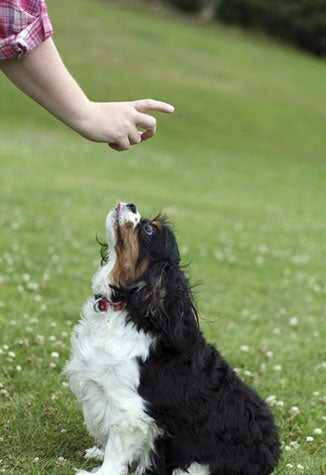Teach your dog to stay, the fun and easy way

“Stay” is a command that tells your dog to remain stationary where you place them until they are released. This can be used in correlation with a movement command such as “sit” or “down” to help the dog know what is expected of them.
There are a lot of ways to teach a dog to stay, but if you want it to be an effective command the key is teaching your dog it is more rewarding to stay put rather than break a position.
The biggest mistake most people make when teaching “stay” is teaching their dog to break that position rather than hold it. For example, if you ask your dog to “stay” walk away and call him to you, you’re actually teaching him to break the position you just asked him to hold. Smart dogs will begin to anticipate your release and the “stay” will be less reliable. Consider teaching your dog a temporary boundary like “wait” or just praising a command like “good sit” until he is released.
“Stay” taught the fun and easy way simply rewards the dog for holding the position by bringing the reward to the dog and slowly adding more time to the length of the “stay” command. Rewards can be food, verbal praise, objects and play time. These are given when we return to release the dog or continually as he holds the “stay” command.

Set Up: Have your dog on a leash and collar. Have something that motivates the dog ready to serve as both your distraction and reward like a handful of treats he loves. You can ask him to “sit” or “lay down” before adding the new command “stay”.
Step 1
Kneel down and hold your dog by the collar or stand on the leash to anchor him from getting to the treats (you may want to have him on a harness so he is not pulling against his neck). Place the rewards at arm’s reach away out in front of him. If he is pulling and trying to get to the reward wait patiently. If he holds the position without pulling, calmly praise him and say “good stay” while you reach one of the rewards. The more the dog pulls for the reward, the longer they wait. Be calm and patient on the first few tries. Keep it short and sweet. Release the dog by saying “OK” and reward them with treats or play. You may need to do a few repetitions before moving on. The dog will begin to connect the behavior of staying with the reward. He will find it is more rewarding to hold still than to try to get the reward himself.
Step 2
Stand up and hold the leash close to you. Say “stay” and toss the reward about two feet away. Wait for your dog to be calm and still. Then reach for the reward to bring it back to him (some dogs will pull and get excited when you touch the reward, be prepared to wait again or drop the reward and wait longer). When the dog is calm and staying patiently, release him by saying “OK” and reward.
Step 3
Same thing as step two, stand on the leash at first, now toss the reward a bit further. Now you are going to have to walk to retrieve the object.
*HINT: Your body language can cause your dog to break his position because many dogs are taught to follow us when we turn our shoulders. Start by facing your dog with your hand outstretched and a flat palm facing him while you back up to retrieve the reward, calmly repeating “good stay”.
Keep praising him and bring the reward back. You can release him and give him the reward. Encouragement is the key. He should enjoy learning to stay put because it is interactive and rewarding. Repeat this several times (maybe for a few days adding more and more time to the length of the “stay” command). If you are consistent he will be waiting to hear you release him by saying “OK” rather than trying to rush to get the reward.
Step 4
Proofing your new command is important. Your dog should be getting good at this game by now. It is time to experiment with different rewards and distractions. If you were using treats as rewards see if you can transition the exercise to a favorite toy. Tell your dog “stay” while you hold the object and walk away. You are going to continue to praise your dog by saying “good stay” while you wiggle and move the object. If he breaks his position calmly return him to the same spot he was supposed to be holding. Eventually you will make it harder as you toss it up in the air and catch it, for other toys drop them and move them around or bounce a ball. As your dog becomes more trustworthy, work on long “stays” where you back away from the object. If your dog is getting really good, hold the leash and tell him to “stay” toss the toy away from you in a throwing motion. Praise him for “good stay” as you go and retrieve the object. Release him by saying “OK” when you get all the way back to the spot you threw it from and let him play with it. He will learn that patience gets him the reward faster than trying to pull or run to it.
Big distractions should have big rewards. The key to proofing is adding the 3 D’s. Distance, Duration and Distractions. Once a dog thinks “stay” is a fun and rewarding command you can start to use this important command often. Practice a few minutes every day in a new location and he will excel quickly.